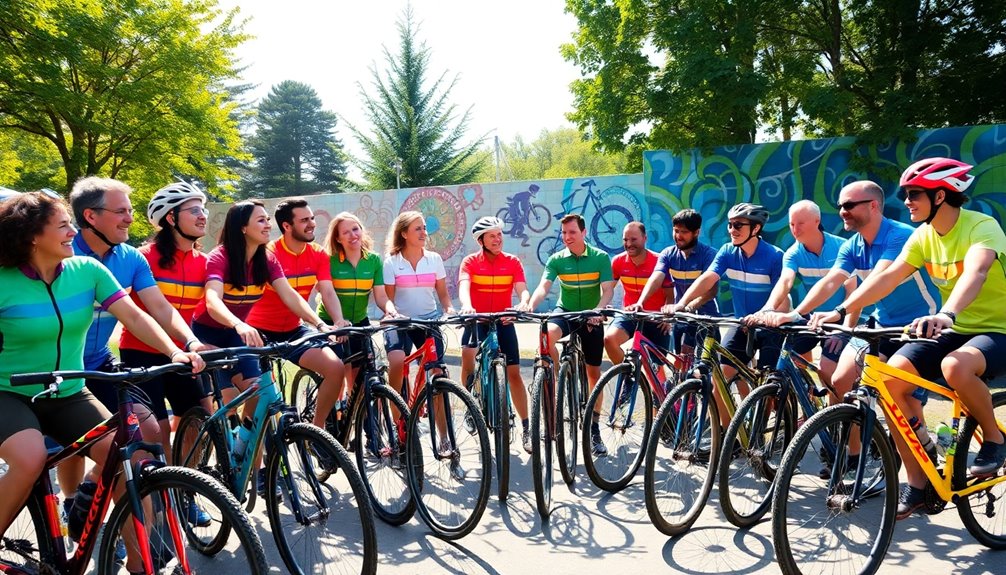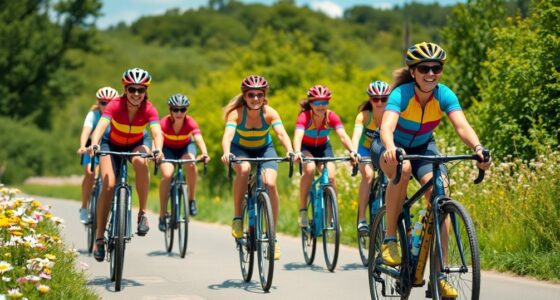Collaboration is key in bringing cyclists together and transforming communities. By working with local businesses, advocacy groups, and educational initiatives, you can create a vibrant cycling culture. Events like community rides, bike festivals, and repair workshops strengthen connections among cyclists while promoting safety and skills. Data-driven incentives foster engagement, ensuring everyone benefits. This collective effort not only enhances the cycling experience but also boosts the local economy. Discover how these initiatives can revolutionize your cycling community.
Key Takeaways
- Collaboration among stakeholders, like the Bike Task Force, leads to targeted improvements in cycling infrastructure, such as better signage.
- Local businesses, including bike shops and cafes, enhance the cycling experience by providing resources and support to cyclists, fostering a vibrant community.
- Advocacy and educational initiatives empower communities by promoting safer cycling policies and offering essential skills to novice cyclists.
- Community rides and bike festivals create connections among cyclists, raising awareness of cycling benefits and celebrating local culture.
- Innovative incentives, like tailored apps and collaborative rewards, encourage greater cycling participation and enhance community engagement.
Building a Bike-Friendly Community Through Collaboration
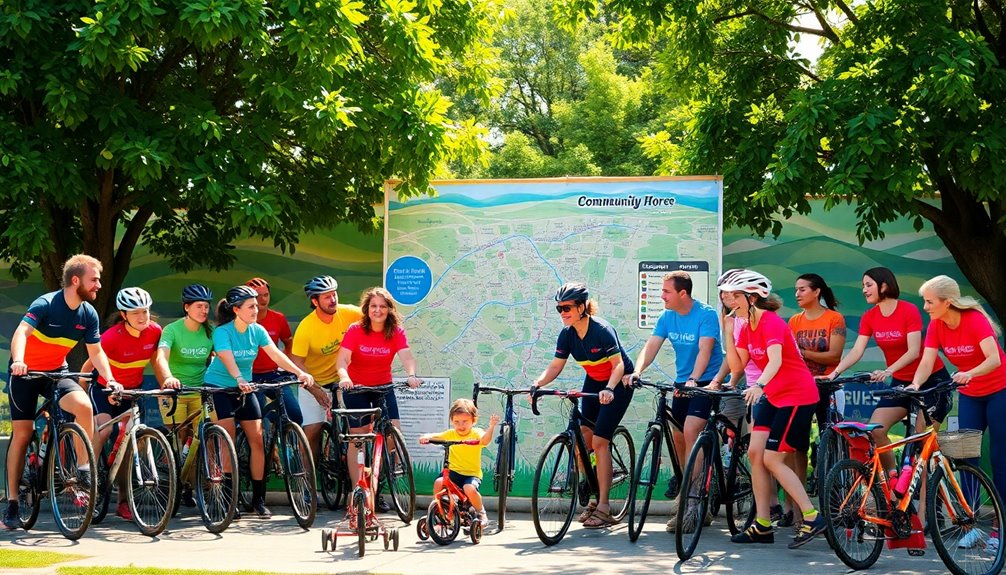
Building a bike-friendly community requires collaboration among various stakeholders, and when citizens take the initiative, real change can happen.
The Bike Task Force (BTF) in Park Ridge exemplifies this, identifying inadequate signage as a critical issue. By engaging in collaborative efforts with city planners, they secured $6,000 to enhance cycling infrastructure.
The Bike Task Force in Park Ridge successfully secured funding to improve cycling infrastructure through collaboration with city planners.
Community cycling initiatives gathered data on missing signs, using GIS technology to pinpoint deficiencies effectively. This partnership streamlined the installation process, showcasing the community impact of teamwork.
Ongoing communication between the BTF and the City guarantees future cycling needs are addressed, fostering a vibrant cycling community.
This initiative serves as a model for other communities, highlighting the importance of stakeholder involvement and data-driven planning for effective cycling infrastructure.
The Role of Local Businesses in Supporting Cyclists
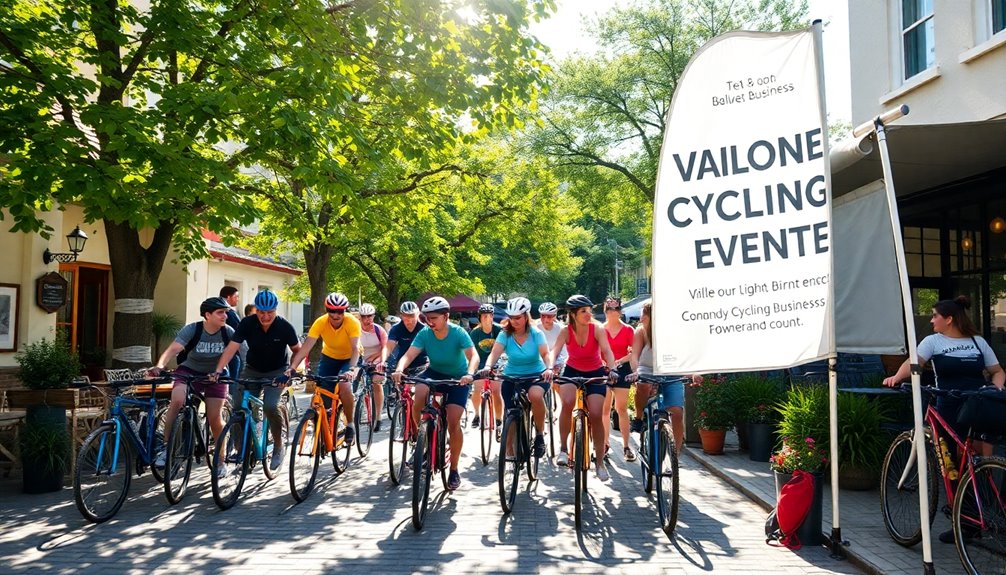
Local businesses play an essential role in fostering a vibrant cycling community, as they provide crucial support and resources for cyclists.
Local bike shops offer specialized equipment and repair services, ensuring you have what you need for your rides. Cafes and restaurants that cater to cyclists—like providing bike racks and discounts—make your experience more enjoyable while boosting their local economy.
Collaborations between these businesses and cycling advocacy groups can lead to exciting community events that promote cycling culture. Plus, studies show that cyclists often spend more than non-cyclists, making them valuable customers.
Advocacy and Education: Empowering Cyclists for Change
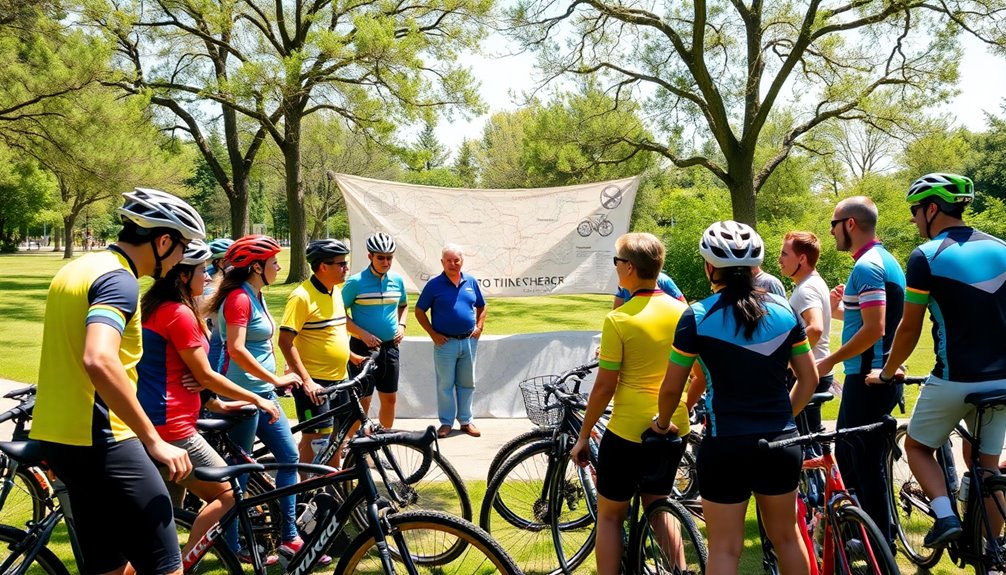
Cyclists can amplify their impact on the community by engaging in advocacy and education efforts. Advocacy groups are essential for promoting safer cycling policies, while educational programs empower you with safety and maintenance skills. By collaborating with local governments, you contribute to informed policy-making that benefits everyone.
| Advocacy Efforts | Educational Initiatives |
|---|---|
| Promote safer cycling laws | Workshops on cycling safety |
| Gather data for community needs | Maintenance skills training |
| Raise awareness on cycling benefits | Community rides and events |
Such initiatives not only strengthen your collective voice but also foster a knowledgeable community. Together, you can highlight the advantages of cycling, like reduced congestion and environmental sustainability, rallying public support for cycling initiatives.
Innovative Incentives: Collaboration vs. Competition

While competition can spark motivation among cyclists, innovative incentives rooted in collaboration often yield greater satisfaction and engagement. Research shows that collaboration-based rewards lead to higher enjoyment for avid cyclists compared to competitive strategies.
Tailored apps like Bike Citizens emphasize community over competition, fostering deeper connections among users. The study involving 57 participants highlighted that those engaged in collaborative setups reported greater intention to cycle.
By leveraging cycling data through GPS tracking and travel diaries, you can design better incentives that align with clear priorities. Understanding individual personality traits also enhances collaboration, allowing for more effective engagement. Incorporating elements of music therapy can further enrich the collaborative experience, supporting emotional regulation and expression among cyclists.
Ultimately, focusing on cooperation can transform your cycling experience, making it more enjoyable and fulfilling.
Engaging the Community: Events and Initiatives for Cyclists
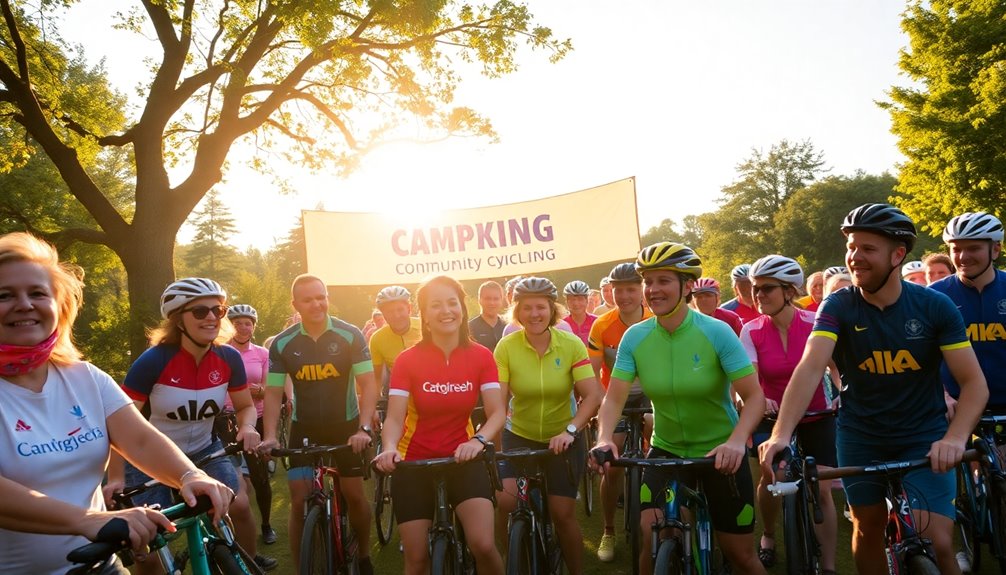
Creating a vibrant cycling community goes beyond individual rides; it's about fostering connections and engagement among all participants. Community rides organized by local advocacy groups encourage residents to connect while promoting cycling as a mode of transport. Educational programs enhance safety and maintenance skills, empowering novice cyclists. Additionally, engaging in community forums allows cyclists to voice concerns and collaborate for better bike lanes.
Events like bike festivals and repair workshops strengthen ties to local businesses, supporting the economy. Grassroots initiatives, including community forums, allow cyclists to voice concerns and collaborate for better bike lanes.
Here's a snapshot of engaging initiatives:
| Event Type | Purpose | Benefits |
|---|---|---|
| Community Rides | Foster connections | Sense of belonging |
| Bike Festivals | Celebrate cycling culture | Strengthen local business ties |
| Repair Workshops | Teach maintenance skills | Empower novice cyclists |
| Advocacy Campaigns | Promote cycling policies | Raise awareness about cycling benefits |
Frequently Asked Questions
Why Do Cyclists Work Together?
Cyclists work together because they recognize the strength in unity.
By pooling resources and expertise, you can develop better solutions for bike-friendly infrastructure. Collaborating allows you to advocate for cycling-friendly policies, increasing awareness and support from governments.
Engaging in community rides and educational programs fosters a vibrant cycling culture, encouraging more people to choose biking.
Ultimately, working together promotes inclusivity and creates a safer, more supportive environment for all riders.
What Are the Shared Responsibilities of Bicyclists?
Some might think cycling's just an individual sport, but you share important responsibilities with fellow cyclists.
You need to follow traffic laws, signal your intentions, and respect road rules to keep everyone safe.
Engaging in local advocacy helps improve cycling infrastructure, ensuring safer routes for all.
Plus, by educating yourself on maintenance and safety, you contribute to a positive cycling culture, fostering respect and community among all road users.
How Can Cycling Help People With Socializing?
Cycling can greatly enhance your social life by connecting you with fellow enthusiasts.
When you join group rides or community events, you'll meet people who share your passion. These interactions foster friendships and create a supportive network.
Plus, participating in workshops and advocacy campaigns can deepen these connections.
As you ride together, you'll not only improve your skills but also build camaraderie, helping you feel more included and engaged in the cycling community.
How Can You Contribute to Improving Awareness and Road Safety for Bicyclists?
Did you know that nearly 800 cyclists die in traffic incidents each year in the U.S.?
You can contribute to improving awareness and road safety for bicyclists by engaging in community workshops and forums.
Collaborate with local advocacy groups to promote cycling-friendly policies and participate in educational programs that teach road sharing.
Organizing community rides can also help foster a culture of cycling, encouraging safe practices and raising awareness among motorists and residents alike.
Conclusion
As you pedal through your community, imagine the thrill of joining forces with local businesses and fellow cyclists. Picture vibrant events where everyone rallies together, advocating for safer streets and more bike lanes. The excitement builds as you discover innovative incentives that encourage participation rather than rivalry. You're not just riding alone; you're part of a movement. So, what are you waiting for? Grab your helmet, and let's shape a bike-friendly future together!
